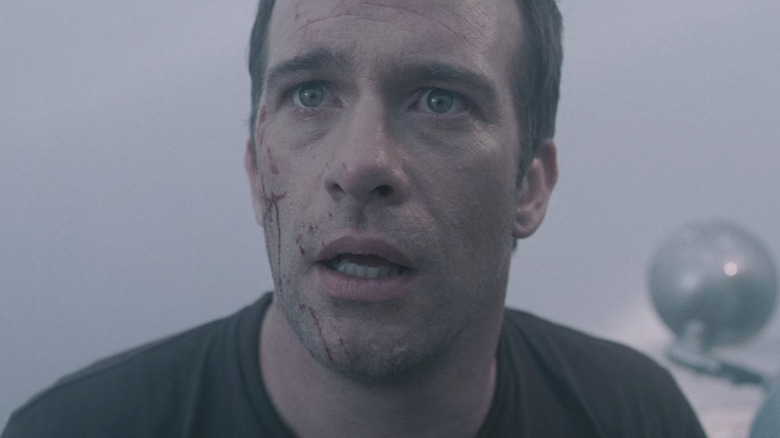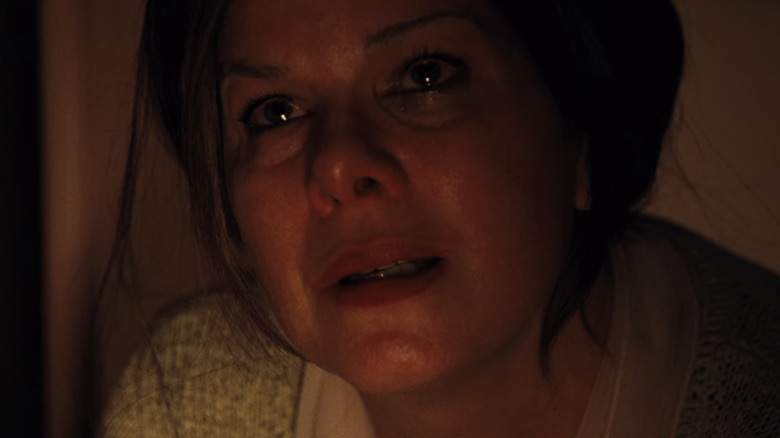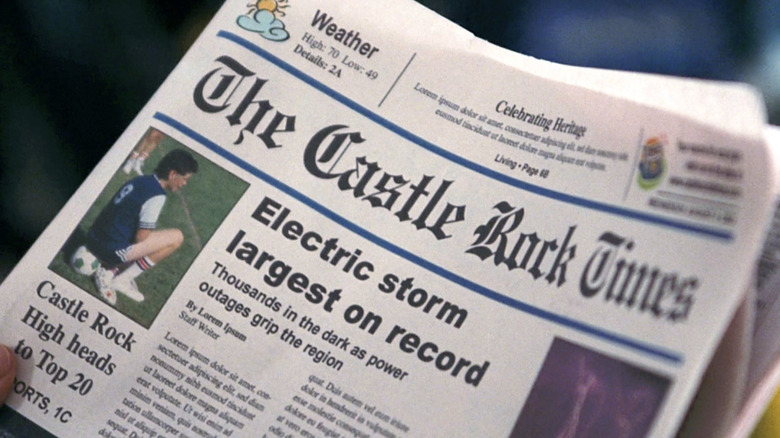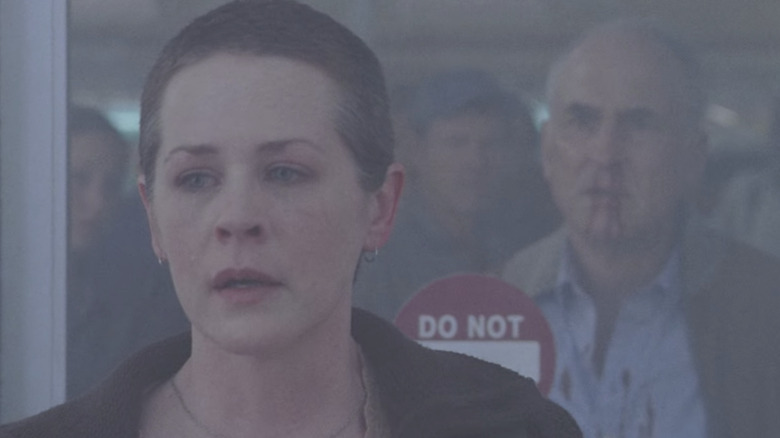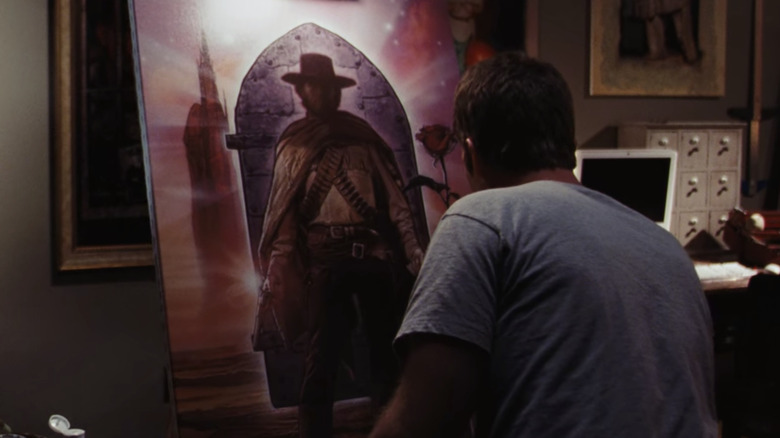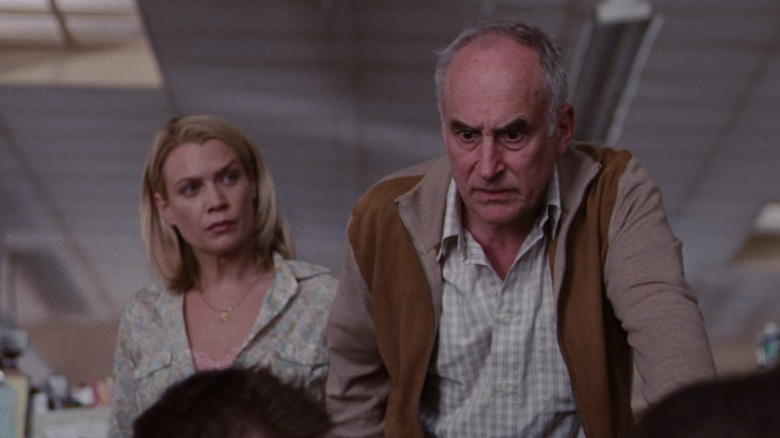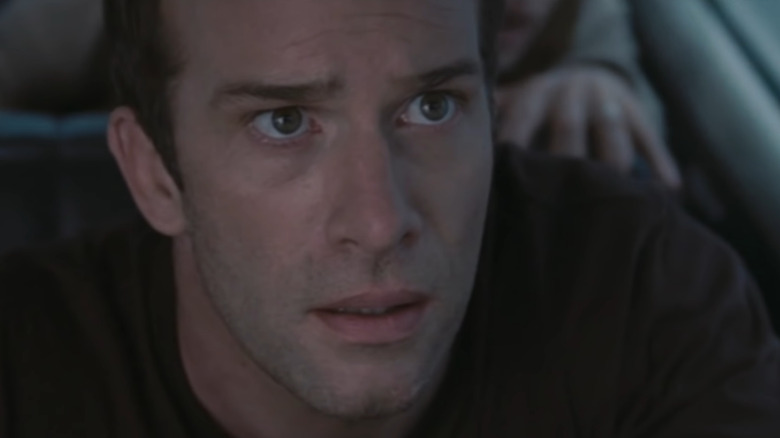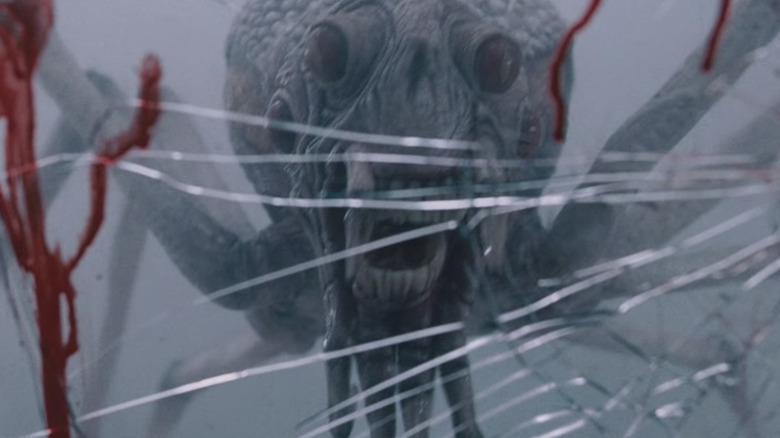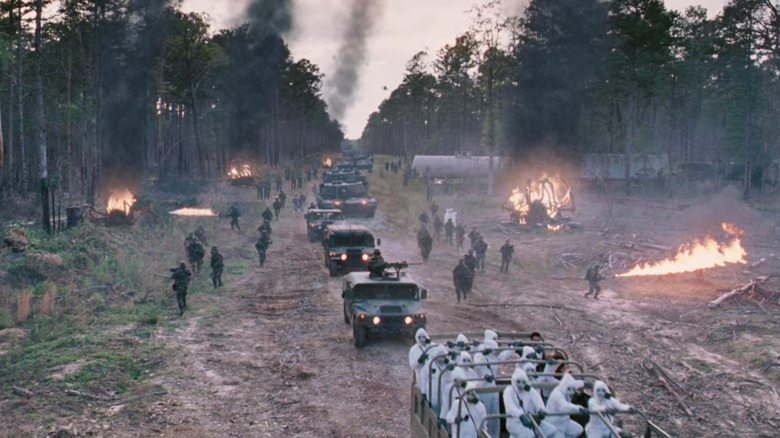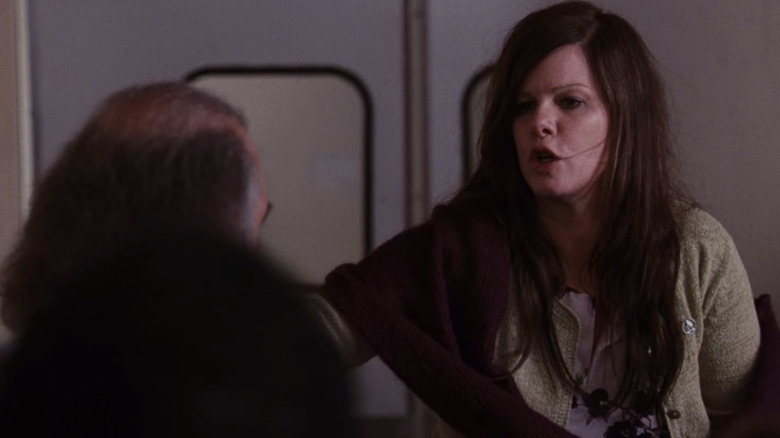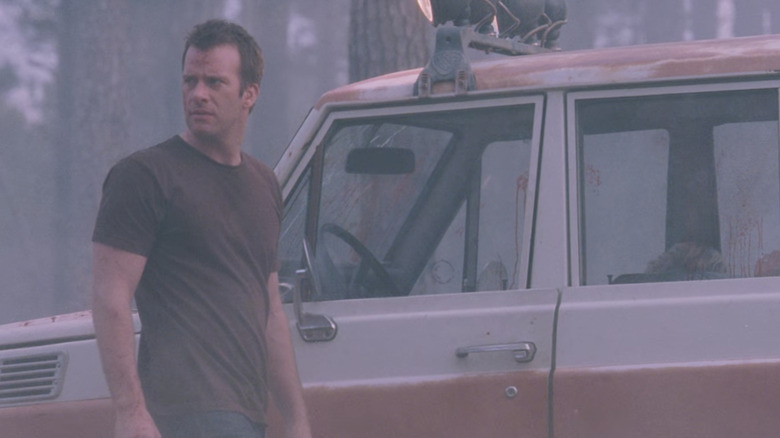Things In The Mist You Only Notice After Watching It More Than Once
At this point, Stephen King adaptations — be they horror or otherwise — are something of a genre all on their own, and almost no one does them better than director Frank Darabont. Known best for his interpretations of King's "The Shawshank Redemption" and "The Green Mile," the final feature film in Darabont's directorial career is one of the most fascinating and underrated horror movies of the 21st century. "The Mist," based on King's novella of the same name, reminds us just what happens when fear takes hold.
Said on the promotional posters to be "Stephen King's legendary tale of terror," "The Mist" is one of those movies that sticks with you for days, weeks, maybe even years after viewing. Besides the thematic content, which revolves around the self-destructive nature of man, the film is most well known for its controversial and somewhat bleak ending. But we'll get to that in a moment. Starring "Punisher" actor Thomas Jane in an incredible performance as artist and father David Drayton, "The Mist" leaves us with little more than dashed hopes and dreams.
But between all the heavy themes and pulse-pounding suspense, it's easy to miss a few things along the way. Whether it's the small references to King's other works or seemingly unresolved plot points, there's a lot going on in "The Mist." Here are some of the things that you might only notice if you watch this Stephen King adaptation more than once, though we wouldn't blame you if you didn't.
Mrs. Carmody doesn't know her Bible
While the otherworldly creatures in the mist might be the biggest threat to our heroes on the outside, inside lies an even more terrifying danger — a religious fanatic named Mrs. Carmody. Played to eerie perfection by Marcia Gay Harden, Mrs. Carmody is up there on the crazy scale, made evident by her call to sacrifice David's young son Billy (Nathan Gamble) to apparently "appease" the Almighty above. Although Mrs. Carmody claims to be a God-fearing Christian, like many of Stephen King's crazed fundamentalists, she's anything but.
On multiple occasions, we see that Carmody doesn't practice the same righteousness she preaches, and that's not even counting human sacrifice — something the God of the Bible condemns in both Testaments. For one thing, Mrs. Carmody falls into the common Hollywood trope of calling the Book of Revelation "Revelations," with an added "s" on the end, showing that she doesn't spend much time in the written word. As Mrs. Carmody quotes scripture out of context, she throws out carefully chosen religious words and phrases such as "Judas" and "Wormwood" to invoke a reaction from her newfound cult of followers, Jim Jones-style — all with hellish profanity.
As both Amanda (Laurie Holden) and the Biker (Brian Libby) point out, Mrs. Carmody's version of God seems a lot more vengeful than the one most Christians believe in — and that seems to be the point. In the end, Mrs. Carmody reaps exactly what she sowed.
King's Pharmacy and The Castle Rock Times
While there are plenty of references and allusions to Stephen King's greater body of work throughout "The Mist," two blink-and-you'll-miss-it visual references flashed by almost as fast as they appeared on-screen. About halfway through the film, David and his group decide to head over from the grocery store to the pharmacy to gather more supplies, find more survivors, and prepare for their eventual escape. As they head over, they find that the poor souls in the pharmacy were all strung up by the Gray Widower spider creatures and used "Aliens"-style as hosts for their offspring.
Though the pharmacy turns out to be a dead end, longtime King fans might've caught the business' name as our heroes entered and exited: King's Pharmacy. Of course, that's not the only direct reference to the "King of Horror." On a newspaper seen near the beginning of the film, we read the paper's title to be The Castle Rock Times. One of three notable fictional towns in King's bibliography, Castle Rock is the primary setting of novels "The Dead Zone," "Cujo," and "Needful Things," as well as the novella "The Body," which inspired the film "Stand By Me."
"The Mist" takes place in the real town of Bridgton, Maine — itself the inspiration for the fictional town of Chester's Mill from King's other work "Under the Dome." Though the feature was filmed in Louisiana, the film's commentary reveals that King remarked that it looked just like Maine.
Quiet and calm keep the creatures at bay
Horror movie monsters are known to have all sorts of interesting ticks. In "A Quiet Place," the aliens are attracted specifically to sound, in "Tremors" it's movement, and in "The Thing," well, all you need is a pulse. "The Mist," however, features monsters that seem to be attracted to all three of these. That is, of course, unless you remain calm and collected as you pass by. That's right — the monsters of "The Mist" are survivable, though only two of the film's characters ever bothered to notice.
The first is the unnamed mother who appears near the beginning of the film played by Melissa McBride. This woman, concerned for his children's safety after she had left them briefly at home, is the first to brave the mist after the grocery store patrons closed the doors. As she walks slowly and carefully, she disappears into the fog without another sound. When the U.S. Army arrives at the end of the film, the woman appears with her children, completely unharmed.
But this woman isn't the only one to recognize this, as Mrs. Carmody discovers that calm quietness is key to survival as well. After she's attacked by the Scorpion-Flies, she calmly prays aloud before the creature takes off again and leaves her behind. While nobody seems to notice, David's group does avoid being eaten by a Behemoth when they keep quiet in their parked car. Though, admittedly, they didn't have any other options.
The Dark Tower references
One of the most prolific writers of our day, Stephen King is also one of the most self-referential. Naturally, this extends to adaptations of King's works as well, and "The Mist" is no exception. Like many stories inspired by King's ever-growing world, "The Mist" takes a moment in its opening, before the title even comes on screen, to show David working on a commissioned piece of artwork for an upcoming film.
The painting itself is of a Clint Eastwood-like Western hero who resembles Roland the Gunslinger, the lead character from King's "The Dark Tower" series of novels. If you look carefully at the painting, you can also see a trans-dimensional doorway behind the Gunslinger, which serves as both a reference to the novels as well as foreshadowing for the horrors to come. Likewise, the titular Dark Tower can be seen in the background, along with a rose to the Gunslinger's right. But David's painting isn't the only reference to "The Dark Tower" we see here.
The film's first monster itself echoes the tentacled creatures described in the novel "The Wind Through the Keyhole," which is set between the fourth and fifth books in "The Dark Tower" canon. But that's not all. One of the quickest nods to "The Dark Tower" series comes from Mrs. Carmody when she says, "My life for you." Though this line comes up in King's work often, it's commonly said to "The Dark Tower" and "The Stand" antagonist Randall Flagg.
There are Walking Dead alumni everywhere
Although it predated the series by a few years, "The Mist" features tons of "The Walking Dead." It's no wonder, though, as the film's screenwriter and director, Frank Darabont, developed the zombie series for AMC, even writing and directing the pilot episode "Days Gone Bye." Though Darabont was fired near the start of Season 2, many of the actors he brought on the show stuck with the band of human survivors beyond Darabont's departure. Well, almost all.
Actor Jeffrey DeMunn — who played fan-favorite Dale — exited the series in protest following Darabont's unceremonious firing. But although DeMunn left, other "The Mist" stars who made their way to "The Walking Dead" stuck around. This included Laurie Holden, who played Andrea in the show's first three seasons; Melissa McBride, who stuck with the series for its entire run as Carol; and Juan Gabriel Pareja, who played Morales, a recurring character in the show's first and eighth seasons. Ironically, Pareja's character in "The Mist" was also named Morales.
Of course, other cast members and crew made their way to "The Walking Dead" over the years — including Sam Witwer, who has an uncredited role in the pilot — but another little-known fact is that "The Mist" convinced Darabont to initially cast Thomas Jane as "Walking Dead" lead Rick Grimes (via Uproxx). While Jane's availability fell through during development — paving the way for Andrew Lincoln — we can't help but wonder what that might've looked like.
That ending sort of comes out of nowhere (or does it?)
Despite the themes of fatherhood and endurance, or even the intense and apocalyptic human-on-human conflicts that predated "The Walking Dead," "The Mist" is probably best known for its bleak and horrific ending. That's right, this one ends with David making the impossible choice of killing his son and their companions so that they aren't all ripped to shreds by monsters. It's brutal, and it seems to come out of nowhere given David's "never give up, never surrender" attitude.
Although David's reaction is admittedly hard to watch, what's worse is the revelation that had he waited only two minutes more, help would have arrived. As the U.S. Army shows up, the monsters are defeated and the mist itself subsides. David, who had made the decision to be eaten by the otherworldly beasts, is left alone in the world. Just as David begins the film by painting alone in his studio, so it ends with him alone, and it feels a step too far.
Although this new ending was shocking to audiences, especially given the more ambiguous ending of the novella, it wasn't exactly without precedent. In fact, at the end of Stephen King's novella, David actually contemplates a mass suicide, though the story ends before he has a chance to follow through. Given the depressing nature of the movie, the novella's a bit more hopeful and may just be the preferred ending for many of us.
The creatures are interdimensional
Throughout "The Mist," the enormous creatures that terrorize our heroes are seen as using the titular fog as cover while they infest and eat those who stand in their way. Though some speculate that they're government experiments gone wrong, or as Mrs. Carmody says, "divine judgment," it's revealed in the back half of the film that they're actually from another dimension entirely. After being rounded up by Carmody's acolytes, Pvt. Jessup (Sam Witwer) reveals that Project Arrowhead was experimenting with windows to another universe, and it's implied that something about the storm opened a doorway instead.
No doubt, these predators are from another plane of existence entirely, one that Stephen King often revisits in his larger body of work. For example, the doorway opened by Project Arrowhead, causing the fog-like substance that surrounds the small town, is called a "thinny" in King's "The Dark Tower" series. These thinnies are described as silver-green clouds of fog, not unlike the mist itself, which open a doorway to "Todash Space" — a dark void from which monsters come.
In the novel "From a Buick 8," King describes a tentacled creature not unlike the one seen in "The Mist." Jokingly called "Tentacles from Planet X" by Mr. Norton (Andre Braugher), this creature's hacked-off tentacle dissolves into a liquid form after longtime separation from the mist, just as they do in King's other novel. We might not know much about these monstrous beings, but we know they're not from our world.
The Army might not be saving survivors
For many, the hopeless ending of "The Mist" couldn't get any worse. After David kills his son and fellow survivors and he's left alone to face the world, the U.S. Army arrives with other survivors of the mist in tow as they destroy what's left of the otherworldly monsters. But that's not the end of the story. Sure, "The Mist" ends here, and we're left with a hollow pit in our stomachs as the credits roll, but the Army's presence in Bridgton might be a bit more sinister than we thought.
As the Army arrives in town, full of soldiers wearing gas masks and other types of containment suits, we see that they're bringing survivors — including Melissa McBride's unnamed character and her two children — with them. This seems a bit odd if they're hoping to first cleanse the town of the various alien creatures — unless they're hoping to cleanse the town of any and all evidence, including survivors. This dark theory ponders the question if what we're witnessing at the very end isn't salvation for Bridgton, but rather the beginnings of a massive cover-up.
While we may never know for sure, this theory makes David's decision a bit easier to stomach, all while heightening our fears about what the government is capable of. Corrupt governments are no strangers to the sci-fi or horror genres, especially when doorways to other worlds are involved, making this theory all the more likely.
Recurring Stephen King-isms
They say "write what you know," and if that's the case for Stephen King then we may have reason to be worried. Throughout his vast bibliography, the prolific author doesn't just revisit similar supernatural horrors, characters, and places — usually located somewhere in Maine — but themes as well. "The Mist," of course, is no exception, though you might not have caught all the King-isms the first time around.
The most obvious recurring trope we see featured in King's work is that of religious fanaticism, embodied in "The Mist" by Mrs. Carmody. We see this same idea embodied by characters in some of King's most popular works, such as "Carrie," "Children of the Corn," and "The Dark Tower." Likewise, we also engage with small-town groups of human survivors, not unlike what we see in "Under the Dome" or "The Stand," as well as themes of perseverance. Admittedly, a vast majority of King's stories follow persistent characters, such as "It" and "'Salem's Lot," but the struggle forward is included among other King-isms due to the author's own experiences with failure.
Not only did the "King of Horror" work plenty of low-paying jobs before his career ignited, but as he wrote in his memoir "On Writing," he almost quit while writing his first novel "Carrie," though his wife encouraged him onward. Though the stakes are much higher in "The Mist," the underlying themes of perseverance are still the same — even if the perseverance of our heroes eventually fails.
Stephen King loved the new ending
For the "King of Horror" himself, adaptations of his own work are often very hit or miss. Stephen King is famously known for hating Stanley Kubrick's interpretation of "The Shining," so much so that the author penned his own television adaptation, somewhat passive-aggressively named "Stephen King's The Shining." Despite hating a number of derivative works of his own stories, King has often praised Frank Darabont's adaptations, including "The Shawshank Redemption" and "The Green Mile."
Although King's original ending for "The Mist" was left ambiguous as David and his group ventured out into the unknown, Darabont wrote a darker, more finite ending that challenged the author's original work. Yet when asked at a press conference about his thoughts on the film's ending, King expressed that he "loved it. It puts a button on it" (via MovieWeb). In later reflections on the film, King remarked, "I thought that was terrific. And it was so anti-Hollywood — anti-everything, really! It was nihilistic. I liked that" (via CinemaBlend).
Of course, King's most famous words when discussing the ending of "The Mist" was that "anybody who reveals the last five minutes of this film should be hung from their neck until dead." That about sums it up, and though it's been over a decade at this point, hopefully Mr. King won't hunt us down for spoiling the big twist ... though, to be fair, the title says "things you only notice after watching it more than once."
